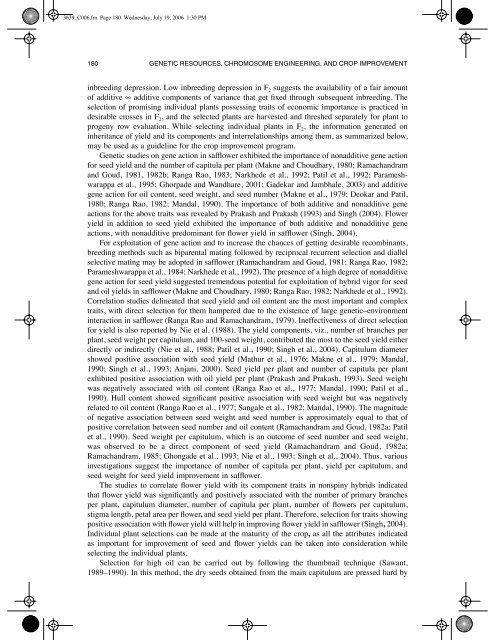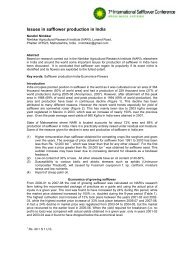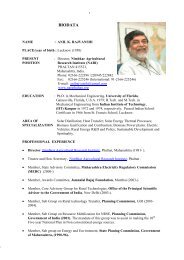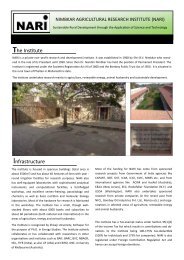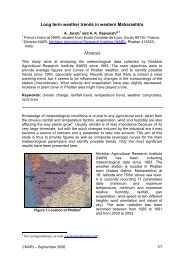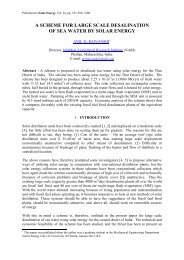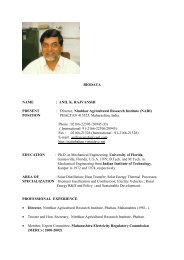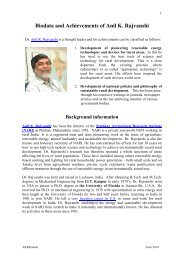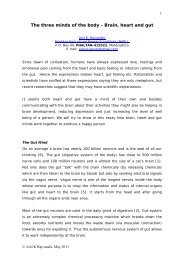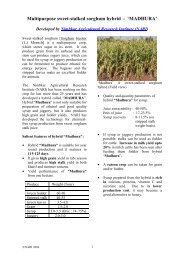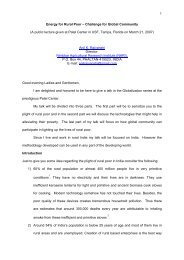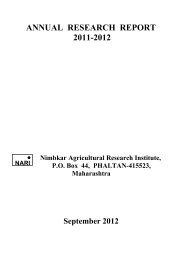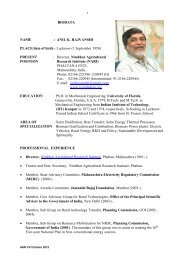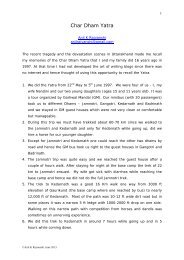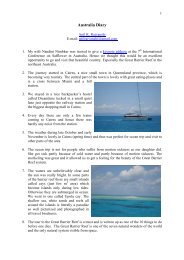3639_C006.fm Page 180 Wednesday, July 19, 2006 1:30 PM180 GENETIC RESOURCES, CHROMOSOME ENGINEERING, AND CROP IMPROVEMENTinbreeding depression. Low inbreeding depression in F 2 suggests the availability of a fair amountof additive ∞ additive components of variance that get fixed through subsequent inbreeding. Theselection of promising individual plants possessing traits of economic importance is practiced indesirable crosses in F 2 , and the selected plants are harvested and threshed separately for plant toprogeny row evaluation. While selecting individual plants in F 2 , the information generated oninheritance of yield and its components and interrelationships among them, as summarized below,may be used as a guideline for the crop improvement program.Genetic studies on gene action in safflower exhibited the importance of nonadditive gene actionfor seed yield and the number of capitula per plant (Makne and Choudhary, 1980; Ramachandramand Goud, 1981, 1982b; Ranga Rao, 1983; Narkhede et al., 1992; Patil et al., 1992; Parameshwarappaet al., 1995; Ghorpade and Wandhare, 2001; Gadekar and Jambhale, 2003) and additivegene action for oil content, seed weight, and seed number (Makne et al., 1979; Deokar and Patil,1980; Ranga Rao, 1982; Mandal, 1990). The importance of both additive and nonadditive geneactions for the above traits was revealed by Prakash and Prakash (1993) and Singh (2004). Floweryield in addition to seed yield exhibited the importance of both additive and nonadditive geneactions, with nonadditive predominant for flower yield in safflower (Singh, 2004).For exploitation of gene action and to increase the chances of getting desirable recombinants,breeding methods such as biparental mating followed by reciprocal recurrent selection and diallelselective mating may be adopted in safflower (Ramachandram and Goud, 1981; Ranga Rao, 1982;Parameshwarappa et al., 1984; Narkhede et al., 1992). The presence of a high degree of nonadditivegene action for seed yield suggested tremendous potential for exploitation of hybrid vigor for seedand oil yields in safflower (Makne and Choudhary, 1980; Ranga Rao, 1982; Narkhede et al., 1992).Correlation studies delineated that seed yield and oil content are the most important and complextraits, with direct selection for them hampered due to the existence of large genetic–environmentinteraction in safflower (Ranga Rao and Ramachandram, 1979). Ineffectiveness of direct selectionfor yield is also reported by Nie et al. (1988). The yield components, viz., number of branches perplant, seed weight per capitulum, and 100-seed weight, contributed the most to the seed yield eitherdirectly or indirectly (Nie et al., 1988; Patil et al., 1990; Singh et al., 2004). Capitulum diametershowed positive association with seed yield (Mathur et al., 1976; Makne et al., 1979; Mandal,1990; Singh et al., 1993; Anjani, 2000). Seed yield per plant and number of capitula per plantexhibited positive association with oil yield per plant (Prakash and Prakash, 1993). Seed weightwas negatively associated with oil content (Ranga Rao et al., 1977; Mandal, 1990; Patil et al.,1990). Hull content showed significant positive association with seed weight but was negativelyrelated to oil content (Ranga Rao et al., 1977; Sangale et al., 1982; Mandal, 1990). The magnitudeof negative association between seed weight and seed number is approximately equal to that ofpositive correlation between seed number and oil content (Ramachandram and Goud, 1982a; Patilet al., 1990). Seed weight per capitulum, which is an outcome of seed number and seed weight,was observed to be a direct component of seed yield (Ramachandram and Goud, 1982a;Ramachandram, 1985; Ghongade et al., 1993; Nie et al., 1993; Singh et al., 2004). Thus, variousinvestigations suggest the importance of number of capitula per plant, yield per capitulum, andseed weight for seed yield improvement in safflower.The studies to correlate flower yield with its component traits in nonspiny hybrids indicatedthat flower yield was significantly and positively associated with the number of primary branchesper plant, capitulum diameter, number of capitula per plant, number of flowers per capitulum,stigma length, petal area per flower, and seed yield per plant. Therefore, selection for traits showingpositive association with flower yield will help in improving flower yield in safflower (Singh, 2004).Individual plant selections can be made at the maturity of the crop, as all the attributes indicatedas important for improvement of seed and flower yields can be taken into consideration whileselecting the individual plants.Selection for high oil can be carried out by following the thumbnail technique (Sawant,1989–1990). In this method, the dry seeds obtained from the main capitulum are pressed hard by
3639_C006.fm Page 181 Wednesday, July 19, 2006 1:30 PMSAFFLOWER (CARTHAMUS TINCTORIUS L.) 181using thumbnail pressure. The seeds with high oil content in general contain thin hulls and are thuspressed easily, in contrast to seeds with thick hulls, which are not pressed at all with thumbnailpressure. Thus, the selection for high oil types can be done in the field. The segregating populationsin F 2 and in subsequent generations, depending upon the trait to be improved, are handled by oneof the methods illustrated below:1. Pedigree method: This method has been used most frequently to improve seed yield, oil content,and other desired traits in safflower. The standard pedigree method, usually used in self-pollinatedcrops, is followed in safflower and is described briefly below.In this method, the selection of plants having desired traits is carried out in F 2 populations. About5 to 10% plants of the F 2 population of each cross are selected, harvested, and threshed separatelyto raise plant-to-progeny rows in the F 3 generation. F 3 progenies may be evaluated in a replicatedtrial along with the standard checks for early-generation selection of the promising progenies forseed yield and desired traits. Selected progenies are advanced to F 4 , F 5 , and F 6 generations insubsequent years. Each generation is subjected to inter- and intraprogeny selection of promisingtypes. The selected plants need to be selfed at every stage of the selection process, as this makesit possible to get homozygous progenies by the time they reach the F 6 generation. Uniform andhomozygous progenies may be considered for yield trial at this stage, and the most promisingones of them may be further subjected to individual plant selections. The individual plant progeniesare further evaluated in replicated trials to identify the most outstanding lines for multilocationevaluation. Multilocation evaluation is necessary to know their adaptability to different agroclimaticconditions before the release of the most adaptable line. <strong>Safflower</strong> cultivars developed by thefollowing pedigree method in India and other countries, along with their years of release forcommercial production, are as follows: India: A-1 (1969), Tara (1976), Nira (1986), Girna (1990),JSI-73 (1998), <strong>NARI</strong>-6 (2001), Phule Kusuma (2003); U.S.: Leed (1968), Sidwill (1977), Hartman(1980), Rehbein (1980), Oker (1984), Girard (1986), Finch (1986); Mexico: Sahuaripa 88 (1989),Ouiriego 88 (1989), San Jose 89 (1990); Canada: AC Stirling (1991), AC Sunset (1995)(Hegde et al., 2002).2. Bulk population method: In the bulk method, the F 2 and following generations are harvested inbulk to grow the next generation. The major benefit of the bulk population method is that naturalselection exerts strong selective pressure on bulk populations favoring the high-yielding types. Asa result, poor yielders and uncompetitive types are eliminated during the process of evaluation ofsix to seven generations and the population becomes nearly homozygous. In the F 7 or F 8 generationthe selection of promising plants carrying desirable traits is carried out. These selections areharvested and threshed separately for evaluation of individual plant progenies in replicated trials,along with standard checks, to identify the most promising ones for multilocation testing. Anotheradvantage of the bulk method is that a breeder can handle several bulk populations simultaneously,which is not feasible in other breeding methods. It is desirable to self bulk populations of safflower,as otherwise the high rate of cross-pollination can make the bulk population method ineffectivedue to the presence of a large number of heterozygous plants at the end of the F 7 generation.3. Single-seed descent method: This method has been used by Fernandez-Martinez and Dominguez-Gimenez (1986) in Spain to develop five safflower cultivars: Tomejil (1986), Rancho (1986),Merced (1986), Alameda (1986), and Rinconda (1986). In this method, from F 2 onwards, randomlyselected single seeds from each plant are taken to increase every subsequent generation until F 5and F 6 . In F 7 , a large number of individual plants are used to raise individual plant progenies. Theoutstanding progenies out of these are then tested for yield and other desirable attributes in areplicated trial.4. Backcross method: This method has been used successfully in the U.S. to breed safflower cultivarsUS-10 (1959), by incorporating resistance to root rot caused by Phytophthora drechsleri (Thomas,1964), and UC-1 (1966) (Knowles, 1968) and Oleic Leed (1976) (Urie et al., 1979), by transferringhigh oleic acid trait to both of them. This method is generally practiced with traits controlled byoligogenes. These genes are to be incorporated from a donor parent into a widely adapted variety.To incorporate a specific trait from a donor parent to the recurrent parent (widely adapted variety),a series of backcrosses are made between the hybrid and the recurrent parent. In each cycle ofbackcrossing, backcross progenies possessing desired characters are crossed with the recurrent
- Page 1: 3639_C006.fm Page 167 Wednesday, Ju
- Page 4 and 5: 3639_C006.fm Page 170 Wednesday, Ju
- Page 6 and 7: 3639_C006.fm Page 172 Wednesday, Ju
- Page 8: 3639_C006.fm Page 174 Wednesday, Ju
- Page 11 and 12: 3639_C006.fm Page 177 Wednesday, Ju
- Page 13: 3639_C006.fm Page 179 Wednesday, Ju
- Page 17 and 18: 3639_C006.fm Page 183 Wednesday, Ju
- Page 19 and 20: 3639_C006.fm Page 185 Wednesday, Ju
- Page 21 and 22: 3639_C006.fm Page 187 Wednesday, Ju
- Page 23 and 24: 3639_C006.fm Page 189 Wednesday, Ju
- Page 25 and 26: 3639_C006.fm Page 191 Wednesday, Ju
- Page 27 and 28: 3639_C006.fm Page 193 Wednesday, Ju


